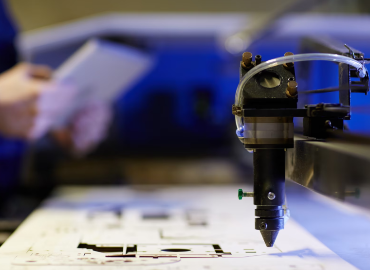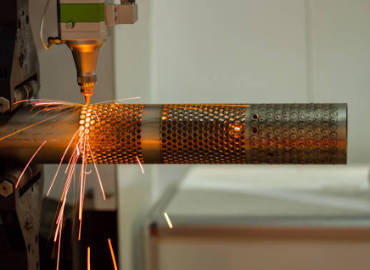In the ever-evolving world of manufacturing and technology, fibre laser machines have emerged as powerful tools for precision cutting and engraving. These advanced machines utilize the capabilities of fibre optics and laser technology to deliver efficient and accurate results. If you are new to the concept of fibre laser machines or looking to enhance your knowledge about their operation, this comprehensive guide is here to help.
A fiber laser machine is a cutting-edge device that employs a fibre optic source to generate a high-intensity laser beam. Unlike traditional CO2 lasers, fibre lasers use optical fibres doped with rare earth elements to produce the laser beam, resulting in increased efficiency and performance.
Components of a fiber Laser Machine
To comprehend how a fibre laser machine operates, it's essential to familiarize yourself with its key components:
1. Laser Source
The laser source is the heart of the fiber laser machine. It generates the laser beam through the process of stimulated emission. The rare-earth-doped optical fibre plays a pivotal role in this process, as it amplifies the light coherently.
2. Beam Delivery System
The beam delivery system consists of various components that guide the laser beam from the source to the cutting or engraving head. These components include mirrors, collimators, and focusing lenses, ensuring the laser's precise delivery to the workpiece.
3. Control Unit
The control unit serves as the brain of the fibre laser machine. It houses the necessary electronics and software to control the machine's movements, power output, and other essential parameters.
4. Work Bed
The work bed is the platform where the material to be cut or engraved is placed. It ensures stability and accuracy during the operation.
How Does a Fibre Laser Machine Work?
Understanding the functioning of a fibre laser machine can be intriguing. Here's a simplified step-by-step explanation of how it works:
1. Laser Beam Generation
The process commences with the laser source creating the laser beam using the rare-earth doped optical fibre. The beam achieves high intensity due to the coherent amplification process.
2. Beam Delivery
The laser beam travels through the beam delivery system, which comprises mirrors and lenses that keep the beam focused and directed towards the workpiece.
3. Material Interaction
When the focused laser beam reaches the material surface, it interacts with the atoms and molecules, increasing their energy levels. This energy leads to the material's heating, melting, or vaporization, depending on the application.
4. Cutting or Engraving
The localized heating, melting, or vaporization of the material results in precise cutting or engraving, leaving behind a clean and accurate finish.
Operating a fibre Laser Machine
Now that we have a basic understanding of the components, let's explore how to operate a fibre laser machine step-by-step:
Step 1: Safety First
Before starting any operation, safety should be your top priority. fibre lasers emit powerful and focused beams that can cause serious injury if mishandled. Ensure you are wearing the appropriate safety gear, including safety glasses, gloves, and any other necessary protective equipment.
Step 2: Power Up
Turn on the fibre laser machine and let it warm up for a few minutes. This ensures the laser source reaches its optimal operating temperature. A stable operating temperature is essential for consistent and accurate laser performance.
Step 3: Material Preparation
Prepare the material you want to process and place it securely on the work bed. Ensure that the material is flat and well-aligned to avoid any errors during the operation. Some fibre laser machines come with integrated computer-assisted design (CAD) software that allows you to design and adjust the patterns directly on the machine.
Step 4: Set Parameters
Access the machine's controller and input the required parameters, such as laser power, speed, and focal length. These settings depend on the material's type and thickness. For instance, thicker materials may require higher laser power and slower cutting speeds.
Step 5: Test Run
Before executing the full design, perform a test run on a small portion of the material. This allows you to verify if the settings are appropriate and make any necessary adjustments. It's crucial to achieve the right balance between power, speed, and focus to ensure clean cuts and precise engravings.
Step 6: Commence the Operation
Once you are satisfied with the test run, you can proceed with the actual laser cutting or engraving process. Keep a close eye on the machine during operation and be ready to halt it immediately if needed. Some advanced fibre laser machines have real-time monitoring features that detect anomalies and pause the process to prevent errors.
Step 7: Post-Processing
After the operation is complete, carefully remove the processed material from the work bed. Check the quality of the cut or engraving to ensure it meets your expectations. For certain applications, additional post-processing steps like cleaning or polishing may be required to achieve the desired final product.
Step 8: Maintenance
Regularly maintain the fibre laser machine by cleaning the optics, checking for any signs of wear, and ensuring all components are in good working condition. Proper maintenance prolongs the machine's lifespan and ensures consistent results. Refer to the manufacturer's guidelines for specific maintenance procedures and intervals.
Tips for Operating a Fibre Laser Machine
Operating a fibre laser machine effectively requires skill and knowledge. Here are some valuable tips to optimize your machine's performance:
1. Calibration:
Regularly calibrate the machine to maintain its accuracy and precision.
2. Material Selection:
Choose the appropriate materials compatible with fibre laser cutting or engraving to achieve the desired results.
3. Focus Adjustment:
Ensure the laser beam is correctly focused on the material for optimal cutting or engraving quality.
4. Power Settings:
Familiarize yourself with the power settings and make adjustments according to the material and the desired outcome.
5. Test Cuts:
Before embarking on a large-scale project, perform test cuts on similar materials to ensure the settings are optimal.
6. Cleaning and Maintenance:
Keep the machine clean and well-maintained to extend its lifespan and ensure consistent performance.
Applications of Fibre Laser Machine
Fibre laser machines find a broad range of applications across various industries due to their versatility and precision. Some common applications include:
1. Industrial Manufacturing
Fibre laser machines are widely used in industrial manufacturing processes, such as cutting and engraving metal sheets, tubes, and profiles. The high precision and speed make them ideal for producing intricate parts and components.
2. Jewellery Design and Production
In the jewellery industry, fibre laser machines enable intricate and detailed engraving on precious metals and gemstones, adding a personalized touch to the pieces.
3. Automotive Industry
In the automotive sector, fibre laser machines are employed for cutting and shaping various automotive parts with high accuracy, enhancing overall efficiency and quality.
4. Electronics and Technology
Fibre lasers play a crucial role in the electronics industry, allowing precise cutting and drilling of electronic components, circuit boards, and semiconductor materials.
5. Medical Devices
In the medical field, fibre laser machines are used to manufacture medical devices and components with exacting precision, ensuring safety and efficacy.
Future Trends in Fibre Laser Technology
As laser technology continues to advance, fibre laser machines are likely to witness further enhancements and developments. Some potential future trends include:
1. Increased Power and Speed
Advancements in fibre laser technology may lead to machines with higher power output and increased cutting and engraving speeds, allowing for faster production and higher efficiency.
2. Integration of AI and Automation
AI-driven automation could streamline the operation of fibre laser machines, making them more user-friendly and efficient.
3. Enhanced Material Compatibility
Future fibre laser machines may expand their material compatibility, allowing for the cutting and engraving of a wider range of substances, including nonmetal materials.
Conclusion
In conclusion, operating a fibre laser machine entails understanding its components, and functions, and adhering to safety measures. This powerful tool has revolutionized the manufacturing industry with its efficiency and precision. By familiarizing yourself with its operation and implementing best practices, you can unlock the full potential of a fibre laser machine and achieve outstanding results in your manufacturing endeavours. So, step into the world of fibre laser machines with confidence and explore the endless possibilities they offer.
Remember, the key to successful operation lies in continuous learning, practice, and a commitment to excellence! Embrace the cutting-edge technology of fibre laser machines and elevate your manufacturing processes to new heights.







